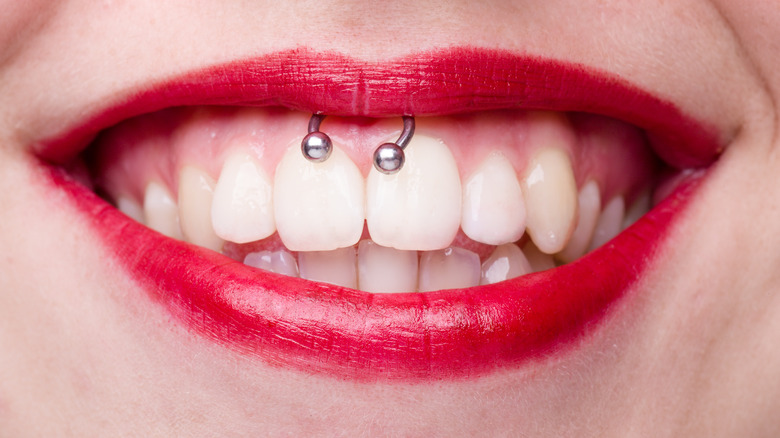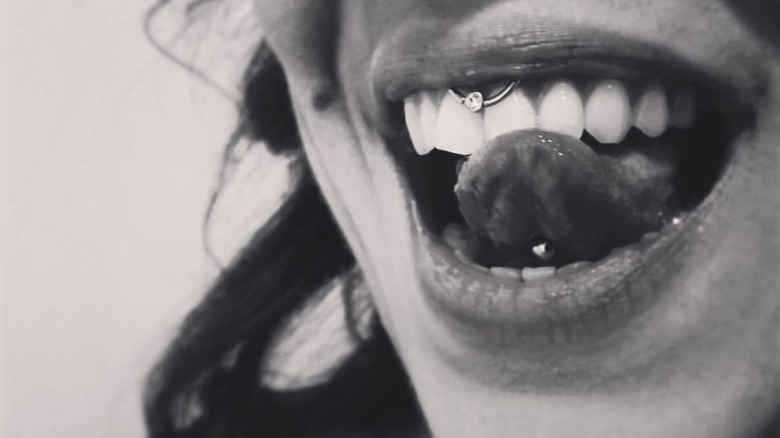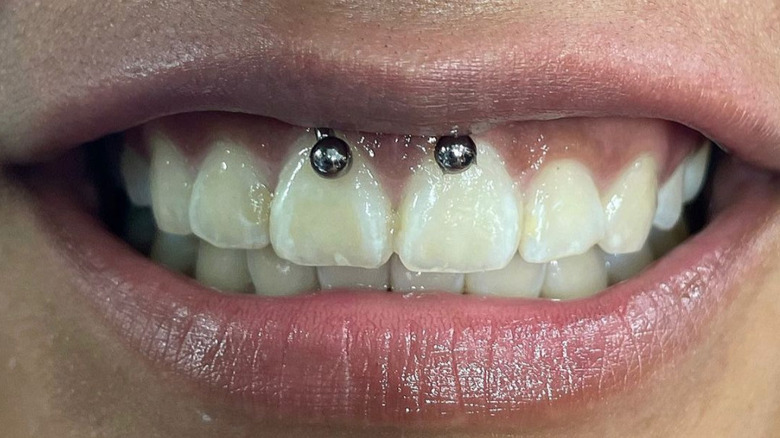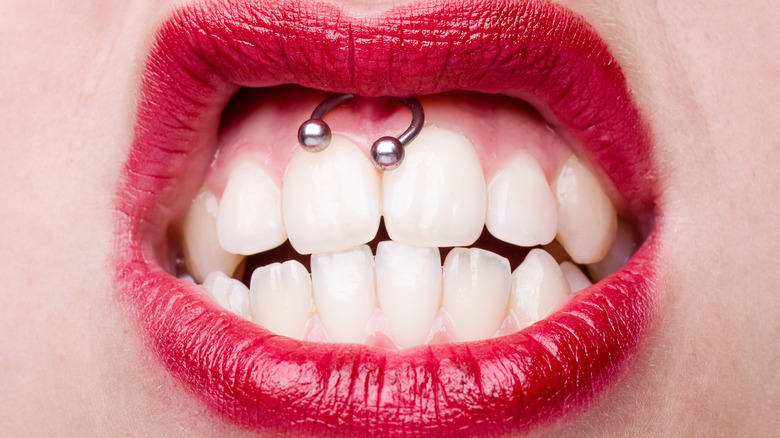The Truth About Smiley Piercings
When you think of piercings in and around your mouth, your mind might go to snakebite piercings or other piercings that go through the lip. Along with tongue piercings, lip piercings have long been popular options for people who want a piercing further down their face, but they're certainly not the only options.
The smiley piercing, which earned its nickname because it's most visible when you smile, is inside your mouth. The piercing goes through the frenulum, which is the thin flap of tissue connecting your upper lip with your gum. Not everybody can get this piercing, as sometimes the frenulum is too small and thin, which leads to a higher chance of the piercing being rejected or ripped out too (via FreshTrends). However, it's one that many people like, so it might be an option for you.
For everything you need to know about the smiley piercing, from pain to the healing process to the style of jewelry available and everything in between, just keep reading.
What to expect with smiley piercings
Smiley piercings are perhaps more painful than you'd think. With the frenulum being such a thin piece of tissue, you might assume that it wouldn't be a very painful area to get pierced, but piercings through thicker skin tend to actually hurt less. You'll probably feel a sharp pain when the tissue actually gets pierced, but the pain should subside. According to FreshTrends, the smiley piercing is considered by some to hurt more than other types of lip piercings but less than cartilage piercings, so they fall perhaps somewhere around average or slightly above on the pain scale.
But before you get a smiley piercing, you'll need to check with a professional piercer to make sure this kind of piercing is right for you. Besides people with too small of a frenulum, according to Healthline, other people who shouldn't get a smiley piercing include those with braces, those with gum disease, and those with dental sealants.
What does it cost?
As for the cost, you can expect perhaps something in the range of $30 to $90, depending on your location (via FreshTrends). Like with any piercing or other modification, it's best not to scrimp on cost. It's worth paying extra if it means the experience will be more pleasant and comfortable.
And, of course, you'll have to pay for the jewelry for your new piercing if it's not already included in the price from your piercer. Luckily, when it comes to choosing the jewelry, you've got plenty of options! At first, you might be fitted with either a horseshoe ring or a captive bead ring, both of which will make an appearance when you smile, while seamless rings are also a popular choice — the opportunities are endless (via FreshTrends)! No matter which type you go for, they'll always look pretty subtle, and they're easier to hide than many piercings if you'd rather not show it when at a job interview or if your great-aunt comes to visit.
What's the healing process like for smiley piercings?
Your mouth tends to heal quite quickly, but there's a lot of bacteria living there too, so the amount of time it takes for a smiley piercing to heal depends on how well you care for it. In some cases, they can heal in as little as four weeks, but it could also take as long as three months.
During your recovery process, it's important to be mindful of what you eat. Of course, you need to eat, but you also don't want to risk irritating the piercing or catching it on anything. You might want to stick to soft foods for a few days, just until you're used to where the jewelry is in your mouth, and any swelling has subsided a little. Stay away from smoking too (via Byrdie), as it can dry out your mouth and introduce more bacteria too (via FreshTrends).
Some of the usual post-piercing tips apply to smiley piercings, too. For one thing, you should largely leave the piercing alone. Try to resist the urge to play with it, as tricky as it might be, and don't touch it if you can.
You'll need to take extra care to avoid infection
You probably already know that piercings require a lot of special care, but since a smiley piercing is in your mouth, you'll want to be even more careful than you would with piercings on other parts of your body. While your mouth already carries bacteria — hundreds of species, in fact, as noted by Healthline — most aren't the "bad" kind that can cause disease. Your immune system usually keeps harmful bacteria in check, but, in the case of infection, bacteria can enter your bloodstream and spread through the rest of your body where it can put you at risk of heart complications.
That means that you need to take extra precautions to keep a smiley piercing clean. Fortunately, there are easy ways of doing that. Per Byrdie, a good way of keeping things infection-free is to use a salt rinse several times a day. Piercing professional Brian Keith Thompson told the outlet that you also "need to make sure that you're keeping your oral hygiene up to par and brushing the jewelry, the backside of it, cleaning it, getting all the plaque and bacteria off."
You'll also want to avoid adding additional bacteria to your mouth as your piercing heals, which means avoiding sharing food and even kissing. The good news is that bacterial infections are rare, especially if you're staying on top of oral hygiene.
Titanium and gold are the best materials for these piercings
While it might be tempting to go out and get a smiley piercing now, don't do it unless you can fork over money for premium jewelry. You might not think there's any harm in getting a cheaper piece of jewelry installed and then swapping it out for a pricier one later, but, as piercing expert Brian Keith Thompson told Byrdie, you get what you pay for. Thompson told the outlet that many people experience "an irritation from trauma from cheaper jewelry," including "jewelry laden with nickel."
Your best bet to avoid this is to get jewelry made from titanium or gold, or to at least not get anything with nickel. According to Thompson, "Nickel is not going to kill you. It's not going to poison you, but it can cause a slower heal."
If you do opt for gold, just be aware that some people can be allergic to gold, and that you should get solid gold rather than something simply plated with gold. While this might mean saving up longer before you can get your smiley piercing, lowering your risk of infection or allergic reaction will be worth it.
Don't change your piercing right away
Another reason that it's a good idea to save up money for quality jewelry for your smiley piercing is that once your new bling is installed, it's going to stay in there for a while. That's because you'll want to leave the jewelry you get the piercing with in until your new piercing is healed up — which can take several weeks. Bodys Jewelry Review recommends waiting three months before you swap out your jewelry to make sure things are really healed.
You'll also want to be very careful during the changing process. This is your mouth, after all, so you want to make sure that you're washing your hands thoroughly before putting your hands in there to change your piercing. It's also a good idea to clean your mouth as part of the process.
If you aren't sure if things are healed enough for you to change your piercing, reach out to your piercer for advice.
There are a lot of risks associated with a smiley piercing
Piercings may seem like a fairly simple body modification, but creating holes in your body doesn't come without risk. Getting a smiley piercing comes with even more risks than your typical piercing simply because of the location. Aside from the potential for infection, Healthline notes that gum and enamel damage are also potential risks as the jewelry could cause friction against your gums or teeth. Even if there's no damage to your mouth and you don't end up with an infection, there's still a chance that your body could reject the new jewelry altogether. In some cases, the body treats the new jewelry as an invader, fighting it off by creating more skin tissue which eventually pushes the jewelry out.
Still more complications of a smiley piercing include bleeding, discharge, and scarring, per Colgate. If anything does go wrong, call your dentist and book an appointment.
Your piercing may not last very long
Smiley piercings are a lot of work and you might ultimately decide that you don't want to keep up with the maintenance they require. So what happens if you want to get rid of your smiley piercing? The good news is that, once you take out the jewelry, the hole will close up. Healthline notes that you should only do this once the piercing has been fully healed, though. If you change your mind about your piercing before the healing process is completed, ask your piercer if it's safe to remove your jewelry.
Be warned that even if you plan to go the distance with your smiley piercing, it probably won't last forever. Per DailyHawker UK, smiley piercings tend to only last for a year or so before the body eventually rejects the jewelry, although it can sometimes last for a few years.








